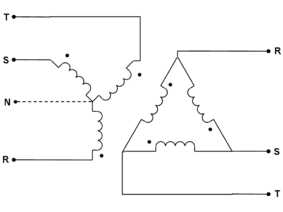Delta-wye transformer

A delta-wye transformer is a type of three-phase electric power transformer design that employs delta-connected windings on its primary and wye/star connected windings on its secondary. A neutral wire can be provided on wye output side. It can be a single three-phase transformer, or built from three independent single-phase units. An equivalent term is delta-star transformer.
Transformers

Delta-wye transformers are common in commercial, industrial, and high-density residential locations, to supply three-phase distribution systems.
An example would be a distribution transformer with a delta primary, running on three 11 kV phases with no neutral or earth required, and a star (or wye) secondary providing a 3-phase supply at 415 V, with the domestic voltage of 240 available between each phase and the earthed (grounded) neutral point.
The delta winding allows third-harmonic currents to circulate within the transformer, and prevents third-harmonic currents from flowing in the supply line. [2] Delta connected windings are not common for higher transmission voltages (138 kV and above) owing to the higher cost of insulation compared with a wye connection. [3]
Delta-wye transformers introduce a 30, 150, 210, or 330 degree phase shift.[4] Thus they cannot be paralleled with wye-wye (or delta-delta) transformers. However, they can be paralleled with identical configurations and some different configurations of other delta-wye (or wye-delta with some attention) transformers.[citation needed]
See also
References
- ^ "Annex D - Three-phase transformer connections" (PDF). IEC. Retrieved 6 January 2013.[permanent dead link]
- ^ Electrical Transmission and Distribution Reference Book,Westinghouse Electric Corporation, 1964, Chapter 5, table 15
- ^ Fink and Beaty, Standard Handbook for Electrical Engineers 11th Edition, Mc Graw Hill 1978, page 17-39
- ^ "IEC Standard 60076-1 Edition 2:1993 consolidated with amendment 1:1999" (PDF). IEC. Retrieved 6 January 2013.[permanent dead link]
